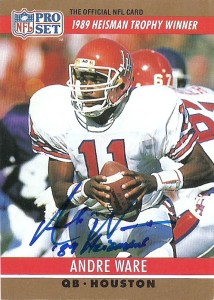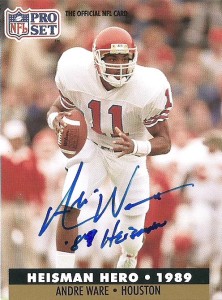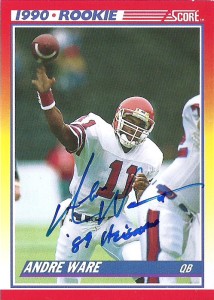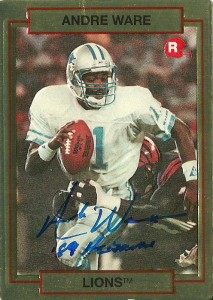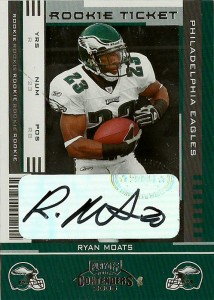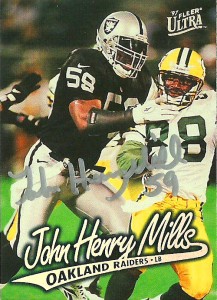 Card: Fleer 1997
Card: Fleer 1997
Acquired: 11/23/2012, Fiterman Autograph Event
John Henry Mills was Houston’s utility player during the dying days of Oilers before the team’s early exile to Tennessee. Mills’ played tight end in college for Wake Forest, and certainly his drafting by the Oilers in the 5th round of the 1993 draft raised some eyebrows. The Oilers had become a Run ‘N Shoot franchise full-time under the direction of Jack Pardee, but after their historic meltdowns in the playoffs, media and ownership were quick to suggest that the reason the Oilers couldn’t close out games was because they didn’t have a tight end. It sounds a bit moronic, (because forget the fact you could just bring in an extra tackle every once in a while,) but ownership decreed that Pardee loosen the reins on the Run ‘N Shoot a bit to include a TE or blocking back in their lineup. John Henry was there to fill that gap, and finished his career at Wake Forest as the college’s acclaimed premier receiver at tight end. His 1,652 yards and 142 receptions were a school record for the position and he earned first team ACC honors from 1990-1992.
It’d be with the Oilers he’d earn a roster spot by being cheap for the team and willing to do anything to make the squad. In fact he was fast enough to stand in at returner in his rookie and sophomore seasons. He could’ve been content to have sat there as the Oilers’ ‘token TE’ but instead he made waves at camp by being tried out at every position possible by the team.At 6’0″, 226, his size, speed, and motor, allowed him to be slotted in at FB, LB, or TE, but it’d be on special teams that the team valued him the most. As a gunner on punts, Mills liked to blend in with the downfield traffic after breaking from his position next to the snapper, then burst out toward the ballcarrier. In 1994 and 1995 John Henry was named to the Pro Bowl on special teams as an alternate for Steve Tasker and then earn the starting Pro Bowl nod as a special teams gunner in 1996. Mills moved on to Oakland in 1997, playing there through the 1998 season and then signed with the Vikings in 1999, making 3 catches for 30 yards, (all career highs) and retired after the season.
G/Gs 100/1 Ret 26 Yds 512 Avg 19.7 Td 0 lg 37
Rec 4 Yds 34 Avg 8.5 Td 0 Lg 14
Tac 14 Fum 4 Sac Int 0 Yds 0 Avg -.- Td 0 Lg -.-
